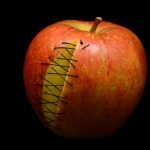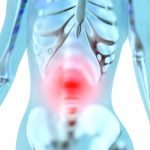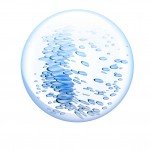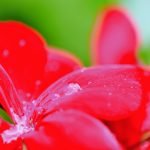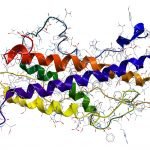Maintaining Healthy Bones: Embracing the Plants
Robin DiPasquale, ND, RH (AHG)
Bones are the framework of our human structure. And yet, they are no good to us functionally without the ligaments and tendons, the levers and pulleys on the joint articulations. They are no good to us without the cartilage, acting as a shock absorber when bone meets bone. They are no good to us without the muscles to initiate movement and exert strength. And they are no good to us unless the bones, themselves, are both strong and flexible.
 Osteopenia and osteoporosis, although initially silent, are degenerative disorders that can be the catalyst for an array of health challenges, as well as the decline of quality of life in the later years. When the skeletal system shows signs of diminished bone strength or flexibility, which can show up as osteopenia or osteoporosis on bone density testing, this is generally a result of long-term imbalances, stressors on the body, and depletion of vital energy. The bones are a repository of minerals, a place where minerals can be stored for future use. Minerals such as calcium are easily given up by the bones when they are needed by the body to balance pH in the blood. If this occurs in excess and mineral reserves become depleted, bone density decreases, and osteopenia or osteoporosis can develop. Since this can be a consequence of many factors, including diet and lifestyle, it is important to look at the whole system to determine the etiology. Evaluate for possible secondary causes, including underlying disorders (table 1), and treat appropriately. Additionally, evaluate for possible dietary and lifestyle factors, and facilitate changes that will create better balance.
Osteopenia and osteoporosis, although initially silent, are degenerative disorders that can be the catalyst for an array of health challenges, as well as the decline of quality of life in the later years. When the skeletal system shows signs of diminished bone strength or flexibility, which can show up as osteopenia or osteoporosis on bone density testing, this is generally a result of long-term imbalances, stressors on the body, and depletion of vital energy. The bones are a repository of minerals, a place where minerals can be stored for future use. Minerals such as calcium are easily given up by the bones when they are needed by the body to balance pH in the blood. If this occurs in excess and mineral reserves become depleted, bone density decreases, and osteopenia or osteoporosis can develop. Since this can be a consequence of many factors, including diet and lifestyle, it is important to look at the whole system to determine the etiology. Evaluate for possible secondary causes, including underlying disorders (table 1), and treat appropriately. Additionally, evaluate for possible dietary and lifestyle factors, and facilitate changes that will create better balance.
Throughout life broken bones can occur, in most cases as a result of an impact or injury. In a healthy body, fractures can be set and allowed to heal over time, eventually returning to full function. Naturopathic modalities such as herbs, homeopathic remedies, nutritional supplements, and energy medicine can accelerate the healing process.
Osteoporosis is not a disorder that afflicts only women and the elderly. However, as women age and move into menopause, hormone levels that have been providing support for skeletal health diminish. Estrogen naturally slows bone loss, so a decrease in estrogen levels can lead to accelerated bone loss. Progesterone promotes bone building through stimulation of osteoblastic activity, hence a diminishment of progesterone lessens this bone-building potential. If a woman has a genetic predisposition to osteoporosis and/or her lifestyle has not supported the building of bone strength and flexibility over the years, the menopausal transition can increase her vulnerability to bone breaks. Men, too, can develop osteoporosis. Proactively supporting and maintaining bone health throughout life helps people to enter their older years as strong and flexible. The triad of adequate rest, regular exercise/movement, and optimal nutrition provides a solid foundation. The addition of nutritional supplements and herbal medicines strengthen and support this foundation.
We could talk a long time about what constitutes adequate rest. I’ll only suggest here that adequate rest means getting enough sleep, deep and uninterrupted, so that you feel rested when you wake, and with enough steady energy to make it through the day without the need for caffeine or stimulants.
Weight-bearing exercise is essential in maintaining optimal bone health. Chopping wood and carrying water is the representation of weight-bearing work that supports both upper and lower body. Since most people in modern society do not have the need to chop wood and carry water in their daily lives, the goal should be to incorporate some regular, weight-bearing, physical practice that stresses the muscles. This in turn leads to tugging on ligaments and tendons that are attached to the periosteum, and the stimulation of active bone turnover. Weight lifting certainly meets this criterion, but so can a regular yoga practice, gardening, cleaning a house, among other life activities. Circulation is also important, as it brings vital nutrients and oxygen to all areas of the body; hence, a cardio workout interspersed with the weight-bearing practice is helpful. Some form of daily movement and strength-building is recommended.
Optimal nutrition is a big topic, and varies depending on each individual’s needs. Basically, whole foods, including protein, good fats, unprocessed carbohydrates, vegetables and fruits, nuts and seeds should be chosen. Many people are concerned about calcium sufficiency and sources of calcium in their diet if they do not eat dairy products. Although dairy is a source of calcium, the calcium/phosphorus ratio is 1:1, which may be less than ideal. Other food sources of calcium are white fish, sardines, salmon, shrimp, crude molasses, torula yeast, carob, and dried figs. While most greens are a source of calcium, some caution should be exercised with high-oxalic acid greens, such as spinach, Swiss chard, and beet greens, as the oxalic acid can bind the calcium, making it unavailable. And while calcium is needed to build healthy bones, it does not stand alone. Other vitamins and minerals to have on board include vitamin D, vitamin K, magnesium, manganese, potassium, boron, strontium, as well as vitamin C, zinc, copper, and silica. Fluoride is considered essential; however, in excess, it weakens the bones. With fluoride in the water and in toothpaste, and fluoride treatments being given at the dentist’s office, fluoride exposure may be substantial enough to contribute to the development of osteoporosis. The use of oligo-elements can assist the body in recognizing and using many of these macro- and micro-minerals.
Calcium and other minerals can also be brought into the diet via bone broth or bone marrow soup. Egg shells and bones, as well as some plants, can be soaked in vinegar, which pulls their minerals into the solution. This vinegar can then be used in the daily diet, providing minerals while also helping to balance the body’s pH. Two favorite high-mineral/herbal vinegars in my own collection are Urtica diocia (nettles), with a green, earthy taste, and Tropaeolum minor (nasturtium flowers and leaves), with a hot, spicy taste. Chenopodium album (lamb’s quarters) contains some of the highest minerals of all garden weeds. Portulaca oleracea (common purslane) can be picked young and pickled and eaten as a condiment, providing both the probiotic benefit of pickled foods and the high-mineral content in the plant. Nutritional supplements may be considered, especially those focused on bone health, particularly in patients who have already been diagnosed with osteopenia or osteoporosis. Orthomolecular dosing may be needed to establish stability. Always select the more absorbable forms.
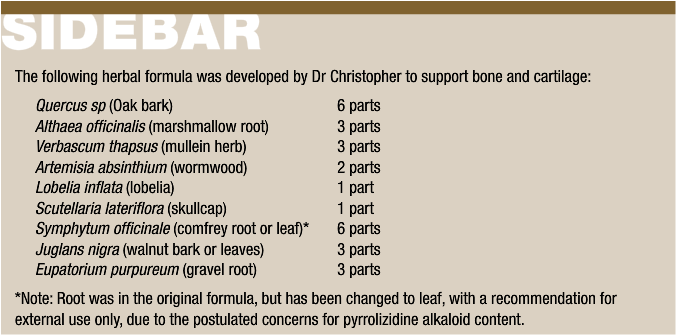 There is a group of herbs that can be taken daily as a tonic for building general bone health, including strength and flexibility. Key herbs include Urtica dioica (nettles), Medicago sativa (alfalfa), Trifolium pratense (red clover), Equisetum arvense (horsetail), Symphytum officinale (comfrey), and Avena sativa (oat straw, or oat pods). This is best prepared as a long infusion, which allows for the extraction of the sought-after minerals. The typical dose is 1 to 2 cups daily; the herbs can be rotated or combined. This tonic is ideally started earlier in life, before bone health begins to decline. It would be an excellent practice for families to introduce these herbal infusions to children as a beverage in place of juices or soda or cow’s milk, allowing them to develop a taste for herbal beverages. Wild plants and fresh herbs can be included in salads, such as Stellaria media (chickweed), Chenopodium album (lamb’s quarters), Taraxacum officinale (dandelion leaves), Portulaca oleracea (common purslane), Trifolium pratense (red clover) leaves and flowers, Calendula officinalis (calendula) flower petals, Amaranthus spp (amaranth), Cichorium intybus (chicory) flowers, Plantago spp (plantain) leaves, Rumex acetosella (sheep sorrel), Rosmarinus officinalis (rosemary), and Viola spp (violets), and Nasturtium officinale (watercress), which is not to be mistaken for Trepaeolum minor— what we normally call “nasturtium.” Fresh nettles can be harvested in the spring and cooked as greens, or dried, powdered, and put in a condiment shaker on the table, combined with other herbs, sea salt, sesame seeds, or seaweed. Cruciferous vegetables, including their newly sprouted seeds, help move calcium into the bones.
There is a group of herbs that can be taken daily as a tonic for building general bone health, including strength and flexibility. Key herbs include Urtica dioica (nettles), Medicago sativa (alfalfa), Trifolium pratense (red clover), Equisetum arvense (horsetail), Symphytum officinale (comfrey), and Avena sativa (oat straw, or oat pods). This is best prepared as a long infusion, which allows for the extraction of the sought-after minerals. The typical dose is 1 to 2 cups daily; the herbs can be rotated or combined. This tonic is ideally started earlier in life, before bone health begins to decline. It would be an excellent practice for families to introduce these herbal infusions to children as a beverage in place of juices or soda or cow’s milk, allowing them to develop a taste for herbal beverages. Wild plants and fresh herbs can be included in salads, such as Stellaria media (chickweed), Chenopodium album (lamb’s quarters), Taraxacum officinale (dandelion leaves), Portulaca oleracea (common purslane), Trifolium pratense (red clover) leaves and flowers, Calendula officinalis (calendula) flower petals, Amaranthus spp (amaranth), Cichorium intybus (chicory) flowers, Plantago spp (plantain) leaves, Rumex acetosella (sheep sorrel), Rosmarinus officinalis (rosemary), and Viola spp (violets), and Nasturtium officinale (watercress), which is not to be mistaken for Trepaeolum minor— what we normally call “nasturtium.” Fresh nettles can be harvested in the spring and cooked as greens, or dried, powdered, and put in a condiment shaker on the table, combined with other herbs, sea salt, sesame seeds, or seaweed. Cruciferous vegetables, including their newly sprouted seeds, help move calcium into the bones.
These herbs should immediately included in the diet of anyone who has been diagnosed with osteopenia or osteoporosis. The herbal long infusions can be incorporated into in daily life, at 2 to 4 cups per day. The herbs can also be taken in tincture or encapsulated form. Cruciferous vegetable extracts are also available in encapsulated form. At this point, additional forms of treatment may be needed. A calcium/magnesium supplement, along with vitamin D3, vitamin K, potassium, and other bone-building minerals mentioned earlier in this article, will help provide the raw materials for bone rebuilding. Schuessler’s tissue salts, or cell salts, assist the body in absorption and utilization of minerals. Specific salts to consider are Calc fluor, Calc phos, Kali phos, Mag phos, and Silicea.
Gemmotherapy can play a significant role in rebuilding of bone in patients with osteopenia or osteoporosis. “Gemmo” remedies for bone support can be given in singles or individually-formulated combinations. I generally keep a patient on a gemmo remedy therapy on an ongoing basis, for at least a year, possibly more, though find that cycling the remedies over time often provides a variety of actions and facilitates greater effectiveness. Here is a list of some gemmo remedies to consider for bone support:
- Rubus fructicosu, (bramble) increases osteoblastic activity and decreases osteoclastic activity.
- Sequoia gigantean (giant redwood) is a 17-ketosteroid precursor, thus enhances osteoblastic activity.
- Malus sylvestris (crab apple) enhances osteoblastic activity and tonifies mucous membranes of the gastrointestinal tract for better nutrient absorption.
- Vaccinium vitis-idaea (cowberry), a female senescence remedy, enhances calcium absorption and metabolism.
- Pinus Montana (mountain pine) supports remineralization and regeneration of bone and cartilage.
- Rosa canina (dog rose) serves as an adjuvant remedy with Pinus Montana to help regenerate bone and cartilage.
- Acer campestre (hedge maple) facilitates remineralization.
- Ulmus campestris (elm) facilitates remineralization.
- Abies pectinata (silver fir) enhances calcium and phosphorus metabolism, and stabilizes calcium.
- Fraxinus excelsior (ash) brings flexibility to bones, like its wood.
- Ligustrum vulgare (privet) nourishes the kidney yin.
- Equisetum arvense (horsetail) enhances digestion/absorption of minerals and is also high in minerals, especially silica.
- Vitis vinifera (grape vine) arrests osteophyte formation.
- Alnus incana and Alnus glutinosa (grey alder and European alder) appear to have a supportive role in prevention and treatment of osteoporosis by modulating inflammation.
From the Ayurvedic and Traditional Chinese Medicine (TCM) perspectives, osteopenia and osteoporosis, as well as the overall decline of bone health, is representative of a depletion of vital energy and a result of long-term imbalances.
In Ayurveda, the vata dosha tends to increase with age, increasing dryness, coldness, and frailty. A vata imbalance can pave the way to osteoporosis. Vata pacification through diet, lifestyle, and herbal medicine can bring about more balance and slow the degeneration of bone health. Vata pacifying through diet includes warm foods, moist foods, with warming herbs and spices. Avoiding stimulants will decrease aggravation of the nervous system. Vata pacifying through lifestyle includes regularity of lifestyle – to bed by 10 pm, up at 6 am, eating meals at regular times, meditating daily, and making time for relaxation. Since vata is the air element, regular massage with sesame oil can increase moisture, to offset the tendency toward dryness.
In TCM, the kidneys govern the bones and bone marrow through Essence, and are responsible for the utilization of minerals. Depletion of kidney qi leads to general debility and aging, as well as depletion of bone health. There are many kidney yin and kidney yang tonics and formulas to consider,2,3 well beyond the scope of this article. Individual formulation is best, as this addresses each person’s unique symptom expression. Here are a few of my favorite herbs that can be used in formulas to support kidney yin and kidney yang:
- Rehmannia glutinosa prepared root (shu di huang)
- Dioscorea villosa rhizome (wild yam)
- Polygonatum multiflorum root (Solomon’s seal)
- Asparagus officinalis root (asparagus)
- Ligustrum lucidum fruit (privet)
- Ganoderma lucidum (reishi mushroom)
- Schisandra chinensis fruit (five flavor berry)
- Lycium barbarum berry (wolfberry)
- Morus albus fruit (mulberry)
Although this article is focused on herbal medicine, I would be remiss if I didn’t include the consideration for homeopathic sarcodes— the homeopathic preparations of organs and glands that are involved in bone health. Examples include thyroid, parathyroid, adrenal, gonads, pituitary, and bone itself. These remedies act as energetic reminders to these organs and glands to bring about balance and optimal function.
Caring for the framework of our human structure requires that we nourish and support all systems of the body from early on, and that we teach our children healthy ways of supporting their own. Living our lives in balance, with attention to basic foundational building blocks, including rest, exercise, and nutrition, will allow us more movement and freedom day to day. Calling on the support of naturopathic medicine, we embrace the ability of the body to re-equilibrate when needed. And as time passes, and normal wear and tear takes place on the body, we will be able to be more healthy and present, especially as we age. In this way, we are able to live our lives with grace.
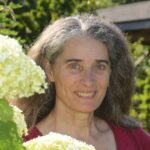 Robin DiPasquale, ND, RH (AHG) earned her degree in naturopathic medicine from Bastyr University in 1995 where, following graduation she became a member of the didactic and clinical faculty. For the past eight years she has served at Bastyr as department chair of botanical medicine, teaching and administering to both the naturopathic program and the bachelor of science in herbal sciences program. Dr. DiPasquale is a clinical associate professor in the department of biobehavioral nursing and health systems at the University of Washington in the CAM certificate program. She loves plants, is published nationally and internationally, and teaches throughout the U.S. and in Italy on plant medicine. She is an anusara-influenced yoga instructor, teaching the flow of yoga from the heart. She currently has a general naturopathic medical practice in Madison, Wis., and is working with the University of Wisconsin Integrative Medicine Clinic as an ND consultant.
Robin DiPasquale, ND, RH (AHG) earned her degree in naturopathic medicine from Bastyr University in 1995 where, following graduation she became a member of the didactic and clinical faculty. For the past eight years she has served at Bastyr as department chair of botanical medicine, teaching and administering to both the naturopathic program and the bachelor of science in herbal sciences program. Dr. DiPasquale is a clinical associate professor in the department of biobehavioral nursing and health systems at the University of Washington in the CAM certificate program. She loves plants, is published nationally and internationally, and teaches throughout the U.S. and in Italy on plant medicine. She is an anusara-influenced yoga instructor, teaching the flow of yoga from the heart. She currently has a general naturopathic medical practice in Madison, Wis., and is working with the University of Wisconsin Integrative Medicine Clinic as an ND consultant.
References
- Brown S. Better Bones, Better Body, Beyond Estrogen and Calcium: A Comprehensive Self-Help Program for Preventing, Halting, and Overcoming Osteoporosis. 2nd ed. Los Angeles, CA: Keats Publishing; 2000.
- Tierra L. Healing with the Herbs of Life. Berkeley, CA: Crossing Press; 2003.
- Bensky D. Chinese Herbal Medicine: Formulas & Strategies. Seattle, WA: Eastland Press; 1990.




